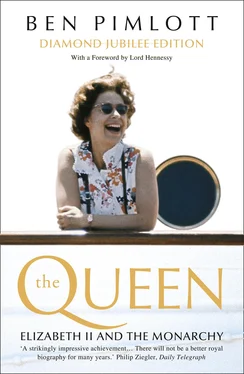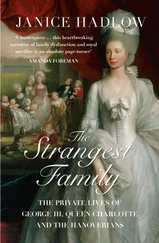1 ...8 9 10 12 13 14 ...55 Sandwiched between morning and evening high jinks came the Princess’s education – or, as many observers have wryly observed – the lack of it. After breakfast with Alla in the nursery, Elizabeth would start lessons in a little boudoir off the main drawing-room, under the supervision of her governess. Later, she would make remarks (sometimes to put nervous, successful people at their ease) about her lack of proper schooling; and it is true that, even for a princess born out of direct line of succession to the throne, her curriculum was far from exacting. 10According to a tactfully understated assessment in the 1950s, it was ‘wide rather than deep’ without any forcing, or subjection to a classical discipline. 11It was, perhaps, a misfortune that there were no peers to offer competition, or examinations to provide an incentive. Most time was spent on English, French and history. 12Elizabeth’s dependence on a single instructor for a range of subjects was a limitation, especially as the instructor’s own education went no further than a training college diploma. Other future Queens of England, also born out of the direct line, had been better served. Nevertheless, in the first half of the twentieth century a home-based education for upper class girls was normal rather than exceptional – the British equivalent of binding feet.
There were two rival versions of the Yorks’ approach to the education of their daughters, and we may dismiss one of them, at least in its simple form. According to the first, semi-official, account the Duchess herself closely supervised her daughters’ lessons, and personally devised a timetable which concentrated on relevant subjects, such as foreign languages, scripture, geography, imperial and constitutional history. This account was the one given to the press, especially after the Abdication. According to the second, the Duchess was quite properly concerned that Elizabeth and Margaret should not regard themselves as different from any other children of their background. ‘She never aimed at bringing her daughters up to be more than nicely behaved young ladies,’ reflected Randolph Churchill, after the war. 13Sometimes the two versions were combined: the best training for a royal life, it was suggested, was a non-fussy, practical education.
Both, however, agreed on one point: the Duke and Duchess were determined, in the best traditions of the British Royal Family and aristocracy, that their children should not be intellectual. According to a newspaper report, when Elizabeth was ten, a regime which involved only seven and a half hours per week in the schoolroom had been designed with a purpose: to ensure that the elder Princess should avoid becoming a ‘blue-stocking’, with all the terrible consequences that that term of derision implied. With the avoidance of such a fate in mind, her studies had been planned ‘in consultation with the leading educationalists in the country,’ and after consideration by the Cabinet. 14
If Crawfie is to be believed, the truth was actually more mundane. Whether or not the topic was ever seriously discussed in the Cabinet Room, it caused little anxiety at 145 Piccadilly. The attitude in the York household towards education seems, in general, to have been one of genial casualness, undisturbed in the early years by any premonition of what lay ahead. Crawfie stressed this last point: perhaps seeking a justification for the lack of pedagogic rigour. Nothing seemed less likely, she insisted, than that the two girls would ever have to play an important role in their adult lives, and consequently their parents’ main concern was to give them ‘a happy childhood, with lots of pleasant memories stored up against the days that might come and, later, happy marriages.’ 15
If the governess had little choice but to accept the relaxed view of her employers, the same was not true of the children’s formidable royal grandmother. Queen Mary – the most serious member of the Royal Family – made purposeful forays into the Piccadilly schoolroom, and was perturbed by what she found. In an attempt to improve matters, she demanded to see a schedule of lessons, urged that Princess Elizabeth should read ‘the best type of children’s books,’ and often chose them for her. She also thought up ‘instructive amusements’ for the children, like a visit to the Tower of London. ‘It would have been impossible for anyone so devoted to the Monarchy as Queen Mary to lose sight of the future Queen in this favourite grandchild,’ recalled the Countess of Airlie. 16This, however, was after the Abdication. Until then, the impact of the Queen’s concern was limited, partly because the Duke took as little active interest in his daughters’ book-learning as the Duchess.
The Duke’s relaxed attitude to female education did not mean, however, that he lacked a social conscience, or sense of royal responsibility. On the contrary: a willingness to keep his own daughters socially cocooned was combined with a strong, even progressive, interest in the plight of children from the urban slums. Before becoming King, as President of the Industrial Welfare (formerly Boys’ Welfare) Association, he was involved in schemes to benefit working-class youth, and he lent his name to the pioneering Duke of York’s Camp – a part paternalist, part egalitarian experiment much in the spirit of the East End universities’ and public schools’ settlements. Each year a hundred public schools and a hundred industrial concerns were invited to send two boys each to a summer holiday camp ‘where all would be on equal terms’. 17The aim, in the words of the organizer, Robert Hyde, was to ‘tame young Bolshevists,’ 18by social mingling: each side of the divide would get to know the other and appreciate its qualities. The Duke made a practice of coming for a day or two and, appropriately clad in shorts and open-necked shirt, joining in the games and singsongs. ‘Class distinction was left outside the camp boundaries,’ observed an admiring journalist. 19At the last of the camps, at Abergeldie near Balmoral in 1939, the princesses came daily to take part. One of the happiest and most natural of pre-war royal film clips shows the four of them, parents and daughters, sitting in a throng of laughing, chanting adolescents. It was the kind of educational activity – boisterous, slapstick, communitarian, classless – that appealed to the Duke and he was proud to show it off to his daughters.
This was as close as the princesses ever got, before the war, to any proper contact with ordinary children, middle or working class, of their own age. The question of whether a wider experience might be desirable was discussed, but discarded. For several years, there was whimsical newspaper speculation that Elizabeth might be sent to a girls’ boarding school. When she was seven, the press reported a rumour that – in a daring break with royal precedent – the Princess was about to be enrolled at a preparatory establishment near London, and, furthermore, that ‘one of our larger public schools’ would be her eventual destination. 20There was nothing in the story, though it is conceivable that the Duchess, who had spent two terms in her own adolescence at a day school in Chelsea, may have been behind it. A few weeks after the initial report, the Sunday Express announced under the headline ‘Will Never Go to School: Too Embarrassing,’ that the Duchess of York had asked that her elder daughter should go to school, so that she would be ‘brought up like any normal girl’. But after discussion with the King, Queen and Prince of Wales, and consultation with Cabinet ministers – according to the paper – she had been forced to back down. 21
Such an account is supported by the recollection of Lisa Sheridan, who remembered the Duchess telling her, just before the Abdication, that ‘she regretted her own daughters would not be able to go to school,’ and was concerned that they should grow up naturally and unspoilt. 22This conversation, which took place during the brief reign of Edward VIII, coincided with fresh reports of a regal veto. The new King, it was stated, had decided against a school for Elizabeth, in accordance with the wishes of his father who had always been opposed. In addition to deference to a dead Monarch, three other arguments were reckoned to have weighed with the Princess’s uncle: the jealousy the choice of any particular school would cause among schools not so favoured, ‘the question of who would be her schoolmates’ – that is, whether she could be protected from bad influences – and, even more spuriously, her need to study different subjects from those taken by most other girls. 23However, neither George V nor his eldest son deserve exclusive blame for the denial to the Princess of the mixed benefits of 1930s boarding school normality. Indeed, their attitude may have been an excuse. Although it would have been difficult for the Duke and Duchess to defy the Head of State, there is no reason why, after his own accession, George VI and his wife could not have reversed the earlier decision, either for their ten-year-old daughter or their six-year-old one, if they had wished to do so.
Читать дальше












